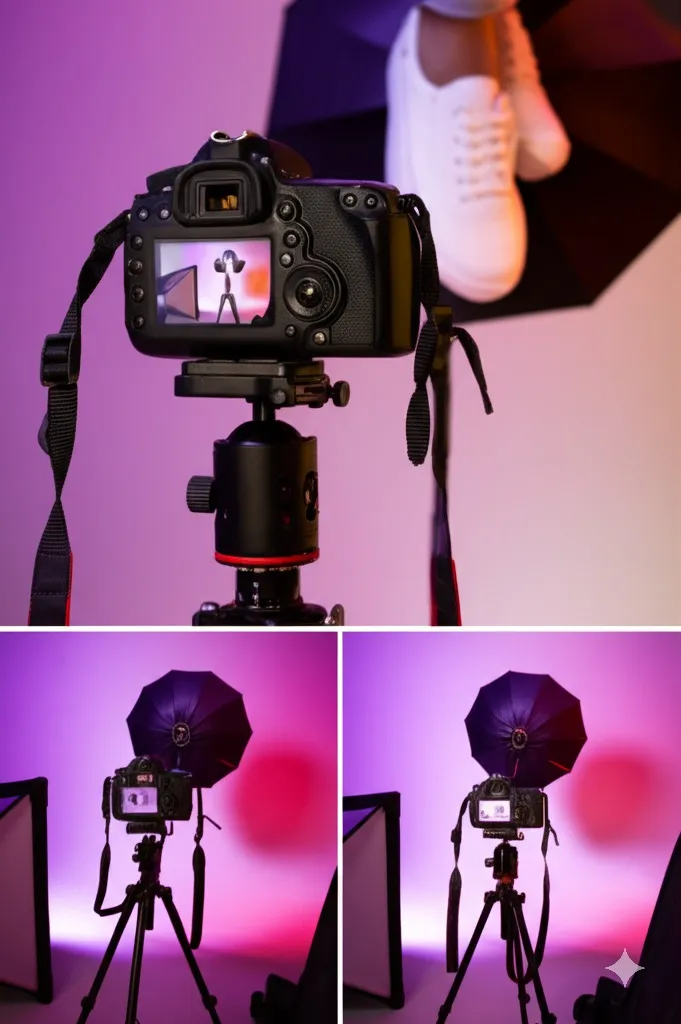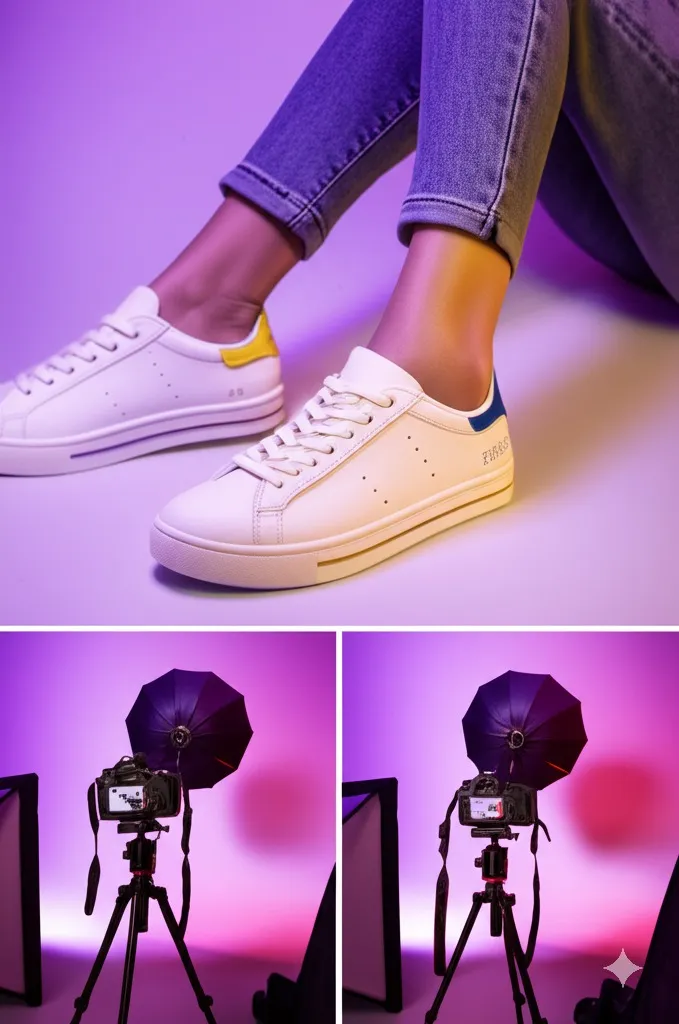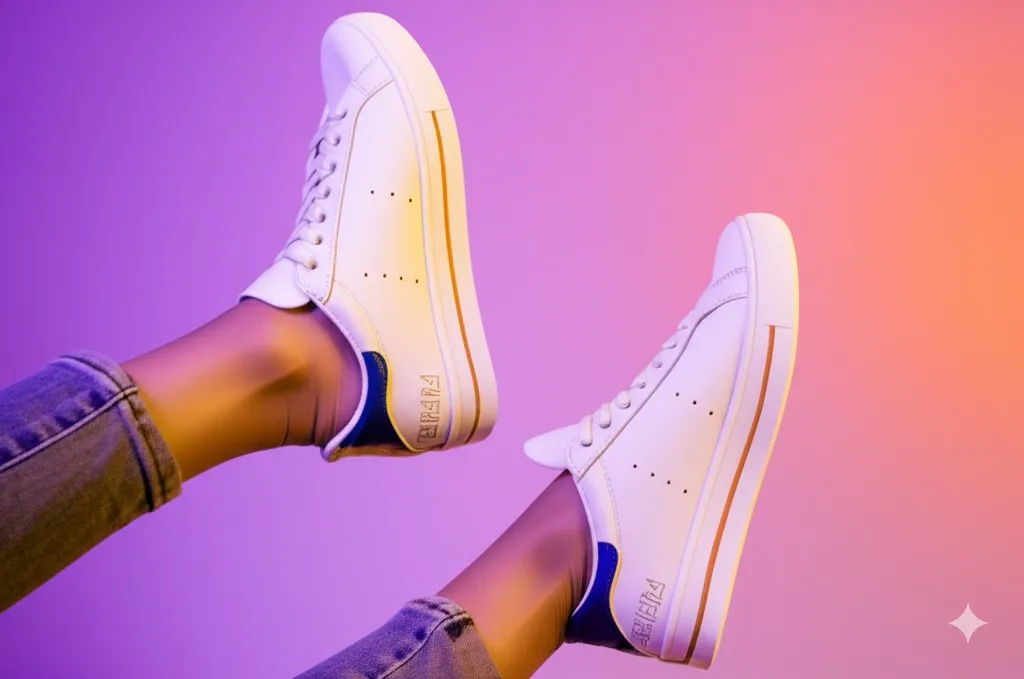Footwear photography is a specialized niche within product photography that focuses on capturing shoes in a visually compelling manner. Whether for e-commerce, editorial spreads, or social media, high-quality footwear photography plays a critical role in showcasing a product’s design, craftsmanship, and appeal. It serves as a bridge between brands and consumers, conveying a story, lifestyle, or aesthetic through carefully crafted images. This chapter provides a comprehensive guide to mastering footwear photography, covering equipment, techniques, planning, post-production, and more.
The Importance of Footwear Photography
Footwear is more than a functional item; it’s a fashion statement, a symbol of identity, and a key driver in the global retail market. Effective photography highlights a shoe’s unique features—materials, stitching, sole design, or branding—while appealing to the target audience. In e-commerce, clear and attractive images can boost conversion rates, while in editorial or lifestyle photography, creative shots can elevate a brand’s prestige. Understanding the purpose of the shoot (commercial, artistic, or promotional) is essential for tailoring the approach.
Equipment and Setup
1. Cameras and Lenses
A high-resolution DSLR or mirrorless camera is ideal for capturing fine details like leather textures or intricate laces. Popular choices include the Canon EOS R5, Nikon Z7, or Sony A7R IV. For lenses, a 50mm prime lens offers a natural perspective, while an 85mm prime is excellent for portraits or isolating details. A macro lens (e.g., 100mm) is invaluable for close-ups of stitching or logos. For budget-conscious photographers, entry-level DSLRs like the Canon Rebel T7 or mirrorless cameras like the Fujifilm X-T30 can still produce professional results.
2. Lighting Equipment

Lighting is the backbone of footwear photography. Softboxes create diffused, even light to minimize harsh shadows, while reflectors bounce light to fill in dark areas. Ring lights are useful for consistent illumination in e-commerce shoots. For creative control, LED panels or strobes with modifiers (grids, gels) allow photographers to shape light. A light tent can be used for perfectly even lighting on white-background product shots.
3. Backgrounds and Props
The background sets the context for the shoot. Seamless white paper is standard for e-commerce, ensuring a clean, distraction-free look. Textured backgrounds like wood, concrete, or fabric add character to lifestyle or editorial shots. Props, such as laces, socks, or complementary accessories, can enhance storytelling but should never overshadow the footwear. For outdoor shoots, natural elements like grass, sand, or urban pavement can create dynamic settings.
4. Additional Tools
A sturdy tripod ensures sharp images, especially in low-light or macro settings. Tethering cables allow real-time image review on a computer. Gaff tape, clamps, or invisible thread can hold shoes in dynamic poses. A color checker ensures accurate color representation during post-production.
Pre-Production Planning
Understanding the Brand
Before the shoot, research the brand’s identity, target audience, and aesthetic. A luxury sneaker brand may require sleek, minimalist images, while an outdoor boot brand might favor rugged, earthy tones. Review the brand’s existing visual content to ensure consistency.
Selecting Footwear
Choose shoes that align with the shoot’s purpose. For e-commerce, include all colorways and angles. For editorial shoots, select statement pieces that reflect the brand’s narrative. Ensure shoes are clean and free of scuffs, though slight wear can add authenticity to lifestyle shots.
Creating a Mood Board
A mood board consolidates inspiration, including color palettes, lighting styles, and compositions. Reference existing footwear campaigns, fashion magazines, or social media trends. Tools like Pinterest or Adobe Spark can streamline this process.
Location and Setup
Decide between a studio or outdoor shoot. Studios offer controlled lighting and backgrounds, ideal for product photography. Outdoor locations, such as urban streets or natural landscapes, suit lifestyle imagery but require planning for weather and lighting variables. Scout locations in advance and secure permits if needed.
Photography Techniques

Composition
Effective composition draws attention to the footwear. The rule of thirds places the shoe off-center for a balanced, dynamic image. Common angles include:
- Eye-level: Mimics how consumers see shoes in real life.
- Top-down: Highlights sole patterns or flat-lay arrangements.
- Side profile: Showcases the shoe’s silhouette and design lines.
- 45-degree angle: Combines front and side views for a three-dimensional look.
Experiment with asymmetry or negative space to create visual interest. For pairs, arrange shoes creatively—parallel, staggered, or one slightly tilted.
Lighting
Lighting enhances texture and mood. Soft lighting (using diffusers or softboxes) is ideal for e-commerce, ensuring even illumination. Dramatic lighting (hard light with shadows) suits editorial shoots, emphasizing contours and materials. Use backlighting to create a halo effect or highlight translucent soles. For reflective surfaces like patent leather, angle lights to minimize glare or use polarizing filters.
Focus and Depth of Field
Sharp focus is critical for showcasing details. Use a narrow aperture (f/8–f/16) for product shots to keep the entire shoe in focus. For creative shots, a wide aperture (f/1.8–f/4) blurs the background, isolating the shoe. Manual focus is recommended for macro shots to capture intricate details like stitching or embossed logos.
Styling
Styling reflects the shoe’s personality. For sneakers, loosely tied laces or a slightly worn look can convey casualness. Dress shoes may require polished, pristine presentation. Experiment with dynamic poses, such as suspending shoes with invisible thread to simulate motion. For lifestyle shots, incorporate models or contextual props (e.g., skateboards for streetwear sneakers).
Dynamic and Action Shots
Capture footwear in motion for energy and context. Photograph a runner mid-stride or a dancer in action to showcase performance shoes. Use a fast shutter speed (1/500s or faster) to freeze motion. Alternatively, flat-lay compositions with accessories (e.g., sunglasses, hats) create shareable social media content.

Post-Production
Editing Software
Adobe Photoshop and Lightroom are industry standards for editing footwear photos. Lightroom excels at batch processing for color correction and exposure, while Photoshop offers precise retouching for imperfections. Free alternatives like GIMP or Photopea can suffice for beginners.
Color Correction and Exposure
Adjust white balance to ensure accurate colors, especially for materials like leather or suede. Use a color checker during the shoot for reference. Tweak exposure and contrast to make the shoe pop without losing detail. For e-commerce, ensure the background is pure white (#FFFFFF) using levels or curves adjustments.
Background Removal
For e-commerce, remove backgrounds to create a clean, isolated product image. Use Photoshop’s Pen Tool or Select Subject feature for precise cutouts. Replace backgrounds with gradients or textures for editorial shots, ensuring the shoe remains the focal point.
Retouching

Remove dust, scuffs, or reflections using the Clone Stamp or Healing Brush in Photoshop. Enhance textures by selectively sharpening areas like soles or stitching. Avoid over-editing, which can make shoes look unnatural.
Exporting
Export images in the appropriate format and resolution:
- JPEG for web and social media (72–150 DPI, sRGB color space).
- PNG for transparent backgrounds.
- TIFF for print (300 DPI, CMYK color space). Optimize file sizes for faster website loading without sacrificing quality.
Types of Footwear Photography
Product Photography
Used in e-commerce, product photography requires clean, consistent images with white or neutral backgrounds. Capture multiple angles (front, side, top, ¾ view) and zoom-ins on details. Lighting should be even, and shadows minimal. These images prioritize clarity and functionality over creativity.
Transform your product photos into stunning visuals that drive sales—try Pixel Retouching’s eCommerce Photo Editing Services today!
Lifestyle Photography
Lifestyle shots place footwear in real-world contexts, such as a hiker wearing boots on a trail or a sneaker enthusiast in an urban setting. Use natural or staged environments to tell a story. Lighting can be more dynamic, and compositions should evoke emotion or aspiration.
Editorial Photography
Editorial photography, common in fashion magazines, emphasizes artistry. Experiment with bold lighting, surreal backgrounds, or unconventional angles. These shoots often involve models, high-fashion styling, and creative direction to align with a publication’s theme.
Social Media Content
Social media demands eye-catching, shareable images. Flat lays, stop-motion videos, or boomerang-style clips perform well on platforms like Instagram and TikTok. Incorporate trending aesthetics, such as vibrant colors or minimalist designs, to align with current algorithms.
Tips for Success
- Highlight Unique Features: Emphasize what sets the shoe apart, such as a unique sole pattern, eco-friendly materials, or custom hardware.
- Maintain Consistency: Use consistent lighting, angles, and editing styles across a brand’s catalog for a cohesive look.
- Experiment Creatively: Try unconventional perspectives, like shooting through glass or using mirrors for reflections.
- Stay Trend-Aware: Follow footwear and photography trends, such as retro-inspired filters or sustainable fashion themes.
- Test and Iterate: Shoot test images and review them on a large screen to catch flaws before the full session.
Common Challenges and Solutions
Reflective Surfaces
Materials like patent leather or metallics reflect light, causing glare. Use diffusers to soften light and polarizing filters to reduce reflections. Angle lights carefully and shoot in a controlled environment to minimize stray reflections.
Shadows and Highlights
Harsh shadows or blown-out highlights can obscure details. Use reflectors to fill shadows and light modifiers to control intensity. Bracket exposures during the shoot to capture a range of light levels for post-production flexibility.
Small Details
Capturing logos or textures requires precision. Use a macro lens and focus stacking to combine multiple images for maximum sharpness. Increase lighting on the detail area without overexposing the rest of the shoe.
Balancing Creativity and Commercial Needs
Clients may demand creative shots that still meet e-commerce standards. Shoot a mix of safe, clean product images and experimental shots. Communicate with clients to align on priorities before the shoot.
Advanced Techniques
360-Degree Photography
For interactive online experiences, create 360-degree views of shoes. Use a motorized turntable and a series of images stitched together with software like Adobe After Effects or specialized platforms like PhotoRobot.
Stop-Motion and Video
Short videos or stop-motion sequences are increasingly popular for social media. Capture a series of stills with slight positional changes (e.g., a shoe “walking” across the frame) and compile them using Adobe Premiere or DaVinci Resolve.
Mixed Media
Combine photography with digital art, such as adding animated overlays or 3D-rendered backgrounds. Tools like Blender or Cinema 4D can create immersive visuals for high-concept campaigns.
Ethical and Practical Considerations
- Sustainability: Use eco-friendly props and minimize waste during shoots, aligning with growing consumer demand for sustainable practices.
- Representation: Feature diverse models and settings to reflect inclusivity, especially in lifestyle photography.
- Copyright and Licensing: Ensure proper licensing for props, music (in videos), or stock assets. Clarify image usage rights with clients to avoid legal issues.
Conclusion
Footwear photography is a blend of technical precision and creative storytelling. By mastering equipment, lighting, composition, and post-production, photographers can create images that captivate audiences and drive brand success. Whether shooting for a global retailer or a niche designer, the key is to understand the shoe’s purpose and audience while pushing creative boundaries. Practice, experimentation, and staying attuned to industry trends will elevate your work in this dynamic field. Start with the basics, refine your workflow, and let each shoot tell a unique story about the footwear you capture.